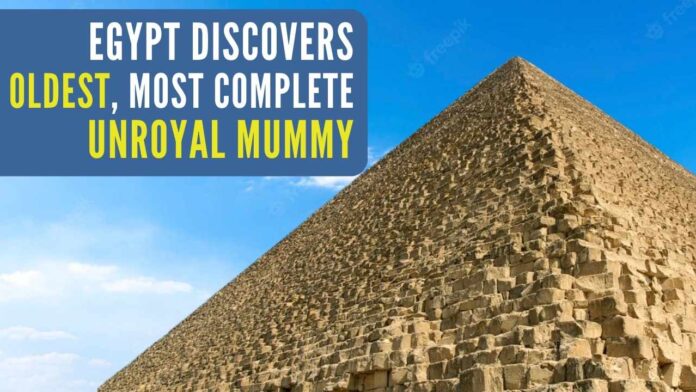
The mummy of a man, Hekashepes, covered with gold leaf, was found inside a large rectangular limestone sarcophagus
Egypt‘s renowned archaeologist Zahi Hawass has announced the discovery of “important tombs hosting a 4300-year-old mummy” in the Saqqara necropolis near the Pyramids of Giza.
“The mummy is the oldest and most complete unroyal mummy found in Egypt to date,” Xinhua news agency quoted Hawass as saying in a press conference on Thursday.
The mummy of a man, Hekashepes, covered with gold leaf, was found inside a large rectangular limestone sarcophagus in a room located under a 15-metre-deep shaft, the archaeologist said.
He added that many stone vessels were seen around the sarcophagus, which was completely sealed when the mission discovered it.
The Egyptian mission also found many amulets, stone vessels, tools for daily life, and statues of the funerary deity Ptah-Sokar at the site, he added.
“The oldest mummy is part of the important discovery of a group of tombs that date back to the fifth and sixth dynasties of the Old Kingdom,” said Hawass, the director of the Egyptian excavation team working with the Supreme Council of Antiquities at Gisr el-Mudir area in Saqqara.
He explained that new discoveries indicated that the site comprises a large cemetery.
According to Hawass, a tomb that belonged to Khnumdjedef, an inspector of the officials, a supervisor of the nobles, and a priest in the pyramid complex of Unas, the last king of the fifth dynasty, is the most important one among the new discoveries.
Khnumdjedef’s tomb is decorated with inscriptions of daily life. The second largest tomb belonged to Meri, who was a keeper of the secrets and assistant of the great leader of the palace.
The mission also found a third tomb for Messi, who is a priest of King Pepi I Meryre, the third king of the Sixth Dynasty of Egypt, and nine beautiful statues, which include one for the priest and his wife, several servant statues, and statues representing individuals.
Hawass added that the mission uncovered another 10-metre-deep shaft comprising a set of beautiful wooden statues, three stone statues representing a person named Fetek, an offering table, and a stone sarcophagus that contained his mummy.
[With Inputs from IANS]
PGurus is now on Telegram. Click here to join our channel and stay updated with all the latest news and views
For all the latest updates, download PGurus App.






If they found any 50-100-200 kgs of gold then ok, else if it is less than 1 kg then effort is not worth…… they have died of economic problems !!!
Western interest is only in dead bodies & exploring divine mathematics in pyramids !!!
Strange they never had any spirituality in them. All our temple structures had pyramid tops, but it never interested them.
Temple have top pyramids are flat & round in nature, unlike Egyptian pyramids which only have flat surfaces on sides.
They like & love dead pyramids, but not living pyramids of temples !!
Gates, Faucci and Tedros need to examine him ( the body) to confirm that he did not die from Covid